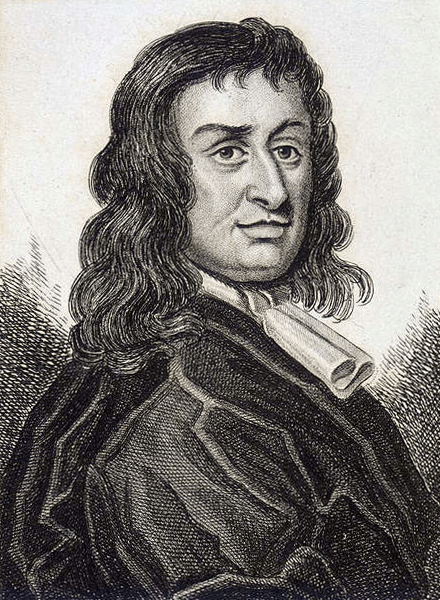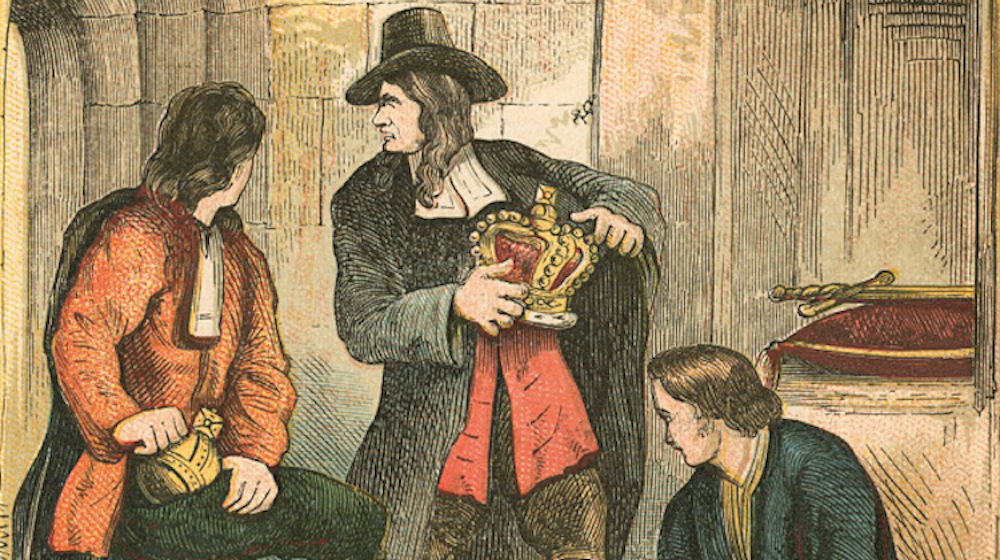Stealing the crown jewels sounds like it might be included in the plot of a James Bond movie or a mysterious spy story.
In the late 1600s, Thomas Blood hatched a plan to steal and sell (or possibly even destroy)the crown jewels belonging to the English crown. This was a brave but foolhardy plot, even in the 1600s.
Yet Blood was successful. And an even more mysterious subplot to this story is that Blood was pardoned and given a living in Ireland! This is one of the most interesting and bizarre stories related to the safety of the crown jewels.
It continues to be one of the hardest-to-explain interactions between a criminal and the king in the history of England.

Who Was Thomas Blood?
Thomas Blood was Anglo-Irish. He was probably born in County Clare, Ireland to a prosperous family.
He often told people that he was a colonel, although he was never specific about which army had granted him that rank. Blood took part in the First English Civil War in 1642. The Crown later granted him lands and a job as justice of the peace following the conflict’s end.
Part of the reason that he was granted lucrative property following the civil war was that he changed sides to join Oliver Cromwell’s Roundheads when he saw the tide of the conflict changing.
Blood was no stranger to intrigue throughout his life. He was involved in a variety of different plots to kill the king and he changed sides readily when there was profit to be made.
Blood also attempted to murder the Duke of Ormond in 1670. This earned him the bounty of 1,000 pounds on his head. This also forced him to take a variety of assumed names to avoid capture.
It might seem like this bounty would have been enough to discourage further illegal actions. However, Blood was using another name when he hatched his plan to steal the crown jewels, giving him an extra level of disguise.
What Were The Crown Jewels?
In the 1600s, the crown jewels were a set of pieces that dated to the civil war period. These items included a gold coronation spoon, an eagle ampulla, and the new St. Edward’s Crown.
This crown was worn at the recent coronation. It was a replacement for the jewels that were melted down in 1649 during Cromwell’s rule over the spending of the monarchy.
The crown was made of solid gold, and it weighed about five pounds. The weight of the item was such that the monarch could only wear it for a few minutes during the coronation before a lighter crown replaced it.
The crown was covered in precious stones, but the stones were changed out after each coronation to be used elsewhere. The crown wasn’t set with permanent jewels until Charles’ reign. This is when the Black Prince’s Ruby was added to the famous piece.
The other items included in the crown jewels were also made of gold and studded with precious stones, pearls, and large amethysts.
The sovereign wore the sovereign’s ring and a pair of spurs. There was also a jeweled sword of the state that was not used other than during the ceremony itself.
But these items were not part of the crown jewels that Blood intended to steal. Blood was mostly interested in stealing the crown, scepter, and orb.
These were made of gold and covered in most of the jewels – Blood’s high target items. They continued to be the prize goal of future theft attempts related to the crown jewels.
How Did Thomas Blood Steal The Crown Jewels?
It is not clear if Blood had an extensive plan for the theft attempt, or if it was a spontaneous attempt.
He was calculated throughout his criminal career. His criminal attempts were opportunistic and bold, which led to his success in most cases.
This particular theft attempt began with Blood dressing up as a visitor and bringing his “wife” to see the jewels. His accomplice who posed as his wife remained nameless.
The woman who was posing as Blood’s wife pretended to have a terrible stomach ache. She was taken to Talbot Edwards’ residence above the location where the jewels were kept so she could rest.

Talbot Edwards and his wife were tasked with protecting the jewels. Yet, their kindly hearts would ultimately open the door for the theft to be completed.
As a thank you for taking care of his “wife”, Blood returned a few days later and delivered some white gloves for Edwards’ wife. Blood became friends with the family over the next couple of weeks.
He earned their trust as he pretended to be a kindly Parson. The Edwards family was so enchanted with “Parson Blood” that they proposed a meeting between their daughter and “Parson Blood’s” wealthy nephew.
During the meeting, Blood asked if he could see the crown jewels and show them to his nephew. Edwards agreed and led the group downstairs, where he unlocked the jewels.
Blood knocked him unconscious and stabbed him with a sword to subdue him.
The group took the jewels and the crown. They flattened the crown with the mallet so it would fit into the bag they brought with them. They even tried to cut the crown in half but gave up when it was clear that the process would take too long.
Edwards regained consciousness as they were bagging the items and began to shout, “Murder, treason!”. This alerted the Tower guards, causing the group of conspirators to attempt to get away.
Blood was caught at the Iron Gate after he stopped to try and shoot one of the guards. When asked why he was willing to undertake such a slight to the English throne, Blood was said to reply with some version of the words, “a gallant attempt, however unsuccessful…but it was for a crown.”
Pardoned for the Crime
Blood was taken into custody, but he refused to talk to anyone but the king.
He likely knew that the king had a reputation for being fond of rebels and scoundrels. Blood was also well aware of his charm. This saved him many other scrapes in his lifetime.
Despite this, the odds were not in Blood’s favor. This was a treasonous crime. When combined with Blood’s other infractions, the outlook for his meeting with the king was by no means auspicious.
In one of the strangest twists of this story, King Charles, Prince Rupert, and the Duke of York, among other family members, decided to pardon Blood. They admitted to Blood that the jewels were not worth the 100,000 pounds that everyone believed they had been valued at.
The items he stole were only worth 6,000 pounds. The value of things like jewels and gold was not carefully established by a set standard during this period.
Standardized valuation processes for jewelry would not be established for many more years. This means that this valuation is hard to corroborate in either direction.
There are conflicting facts about the worth, however. There are quotes from other monarchs that stated that the crown jewels and other artifacts were rumored to be worth far more than their actual value.
Popular opinion and rumor were much easier to spread in days where corroboration was not easily and quickly found. Blood likely believed the value of the jewels. He most likely was not seeking to steal the crown jewels solely to sell or melt them down.
The king asked Blood if he should give him his life and a pardon. Blood supposedly said that he would strive to deserve such a gift. The king gave Blood a pardon and also granted him Irish lands that were worth 500 pounds a year.
Lord Ormonde recorded his disgust with this outcome, but the King stood by his decision. This choice to pardon someone who committed a treasonous act of this nature baffled historians for generations.
Perhaps the king was worried about an uprising by those who were loyal to Blood and his rebellious ideas. The king was also well-known for his love of those who broke the rules, and this alone might have been enough to convince him to pardon Blood.
After the Pardon
After he was pardoned, Blood was still spotted around London and made frequent appearances in court.
He would later run out of his infamous luck and he ended up in prison because of a conflict with the Duke of Buckingham. When he was released from prison in 1680, he left the city but died shortly after returning home to Bowling Alley.
Talbot Edwards, who survived the attack by Blood and his accomplices, was unable to gain a pension until the very end of his life. It is possible that this was preferable to being held accountable for the theft in a more serious way.
As a servant of the crown who failed in his duty in such a public way, it was likely a very hard road for Talbot to ensure his survival in the years after the theft.
The crown jewels had to be extensively restored after the events of Blood’s theft. The crown was bent back into shape. Some dents were removed from items like the orb. Some of the jewels were lost in the caper and were replaced with other precious stones.
The jewels were moved to the Martin Tower, where they were kept under armed guard thereafter. They were kept behind a massive iron grill but were still allowed to be viewed by the public.
The Legacy of Thomas Blood
To this day, the daring crime that Blood attempted has not been repeated.
The crown jewels are now guarded by a full complement of professional guards and have been ever since. This might be one of the most lasting legacies of Blood’s efforts to steal the precious items.
Thomas Blood is a character who fascinated historians for generations. Few people have tangled with the British crown, causing such an affront, but without suffering serious consequences.
While Blood was one of the most notorious of the scoundrels that the monarchy supported and flattered, other duplicitous and clever men influenced British history in the generations to come. None of these men would make an effort to pull off such an infamous theft, however.
Today’s crown jewels are carefully guarded, and modern security prohibits any effort to take them. This allowed the collection of items to safely grow in a way that was not possible in the 1600s.
The crown jewels have been used for every coronation since they were moved to their better-protected location in the tower. The coronation regalia is one of the most beloved parts of the British crown’s possessions.
It’s possible that they might not have been safe for so many generations without the audacity of Thomas Blood.
References
Andrews, Evan. “The Man Who Stole the Crown Jewels.” History.com, 2 Dec. 2019, https://www.history.com/news/the-man-who-stole-the-crown-jewels. Accessed 9 Apr. 2023.
Cartwright, Mark. “Colonel Blood & the Theft of the Crown Jewels.” World History Encyclopedia, 24 Feb. 2022, https://www.worldhistory.org/article/1953/colonel-blood–the-theft-of-the-crown-jewels/. Accessed 9 Apr. 2023.
“WHAT ARE THE CROWN JEWELS?” The Tower of London, https://www.hrp.org.uk/tower-of-london/history-and-stories/the-crown-jewels/#:~:text=Thomas%20Blood’s%20theft%20of%20the,one%20to%20seize%20Dublin%20Castle. Accessed 9 Apr. 2023.
Johnson, Ben. “The Theft of the Crown Jewels.” Historic UK, https://www.historic-uk.com/HistoryUK/HistoryofEngland/The-Theft-of-the-Crown-Jewels/. Accessed 9 Apr. 2023.
Johnson, Ben. “What Happened to Colonel Thomas Blood?” Historic Extra.com, https://www.historyextra.com/period/stuart/the-strange-escapades-of-colonel-thomas-blood/. Accessed 9 Apr. 2023.

